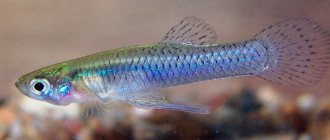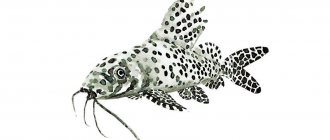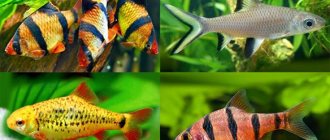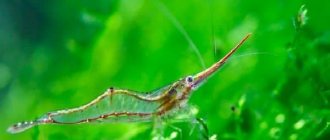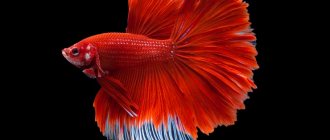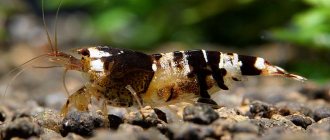Werner's Iriatherina (lat. Iriatherina werneri) is a fish that amazes with its body shape and color. The elegance and beauty are even more impressive when you realize that it is no more than 5 cm in length. And if you take into account that most often you see it for the first time on sale, where the fish is stressed and pale, then all its beauty can only be appreciated in a home aquarium.
A school of Werner's Iriatherinas during spawning is one of the most spectacular species you can watch. But it is better for aquarists with some experience in keeping iris to keep them. Werner's Iriatherines have a very small mouth, and they eat slowly and timidly, so they can often remain hungry in a community aquarium. In addition, they are demanding regarding water parameters and their changes.
Habitat in nature
The fish is naturally found in the waters of northern Australia, the islands of New Guinea, and Indonesia. To know how to ideally design a home for rainbow fish, you need to imagine its living conditions in natural reservoirs: swampy, with a slight current, warm, with an abundance of plants and snags. A world where the sun shines every day and there is always somewhere to hide. The lifespan of Iriatherina Werner in nature is up to 5 years. How long they live in an aquarium will largely depend on the owner, usually no more than 4 years.
Where are they found?
Their homeland is the southern regions:
- Australia (Jardine and Edward rivers);
- Papua New Guinea (Maro and Fly rivers);
- Indonesia.
Iriatherines swim in slow-moving rivers and swamps with clean fresh water. They live at a depth of up to 1.5 meters. Their favorite places are snags and dense thickets (it’s convenient to hide and spawn there).
External characteristics
The body of Iriatherina is elongated, spindle-shaped, with prominent fins. Toward the mouth, the fish's snout becomes narrower and sharper, allowing it to easily collect food from the surface of the water. Body size – up to 5 cm (usually they grow no more than 3 cm in an aquarium).
The description of the species gives two varieties:
- New Guinea - the main background of the body is olive, with different colors spreading across it: from light gray to yellow, and from yellow to bright orange. Under certain lighting, light vertical stripes are also noticeable in areas of color transition;
- Australian is lighter, with a silver background and less bright iridescent spills. At first it was believed that these were two different species, but later they were combined into one.
The dorsal fin of the fish is divided into two parts, the first is in the shape of a rounded lush sail, and the second has two long rays. The shape of the caudal fin is lyre, with pointed elongated rays along the edges. The rays make the fish look like a space princess from other galaxies. The color of the fins continues the iridescent iridescence of the body: blue, purple, dark red and black.
Reproduction of Werner's ireatherine
Getting melanothenial fish to produce offspring is not at all a difficult task. The easiest way is to fill the spawning container with small-leaved aquatic grass and place several breeder nests there, and after a week or a little more, using a magnifying glass, it is easy to detect small clusters of eggs hanging on the branches of plants. It is the Iriatherines that have engaged in self-seeding reproduction.
Much bigger problems will begin for the aquarist when the larvae hatch from the eggs.
The thing is that it may not be possible to choose a starter food the first time.
Iriatherine babies are very picky about their choice of food - some prefer the ciliate - slipper, others give phylodine, and still others are ready to do anything for the sake of a freshly hatched saltwater rotifer.
In general, an amateur who dreams of raising fry of Iriatherina will have to suffer, trying different food options, based on the taste preferences of the tiny fry. When the fry begin to consistently eat the food offered and stop dying, then you can celebrate the victory.
Good luck in getting offspring.
How to keep Iriatherina Werner
The brightness of the color, size, length of the rays - all this depends on the content and feeding. In order for the fish to remain healthy and active, it needs good conditions and maintenance of the correct water parameters.
Arrangement of the aquarium
- Volume – from 65 liters for 10 fish. The minimum flock is 8 pieces, they can be placed in a 50 liter aquarium;
- Soil – neutral color (snow-white quartz, river pebbles), fraction 2-3 mm, height 5-6 cm;
- Filtration and aeration are mandatory. It is better if the air is supplied through a separate compressor;
- Decor – as natural as possible, driftwood, piles of stones;
- Plants must be present in abundance, tall enough to allow one to swim among them;
- Lighting is standard, with breaks in the dark, it is better to use a special aquarium lamp;
- A lid is welcome.
Water parameters
Important! If you plan to breed these aquarium fish, the values should be different (see below). Here are the standard parameters for a comfortable life.
- Temperature 22-29°C, if there are temperature changes in the room where the aquarium is located, a special adjustable heater is needed;
- Hardness 5-20°;
- Acidity 5.5-8.0 pH;
Maintenance and care
- Cleaning the soil with a siphon 2 times a month;
- Change a small amount of water weekly (about 1/4).
Keeping Iriatherina verneri in aquariums
These peace-loving fish have long been inhabitants of Australian aquariums, and came to Europe at the end of the last century. They are also known in the domestic aquarium hobby, but are not widely used. And completely in vain.
The fact is that verneries are almost ideally suited both for nanoaquariums (with a capacity of 25–30 liters for a flock of 5–6 fish) and for ordinary indoor aquariums (50–70 liters) in the vicinity of calm inhabitants: other species of iris , small characins, shrimps, corydoras. In short, they can be freely kept with any peace-loving living creatures.
Required water parameters:
- temperature in the range from +23 to +30 degrees;
- acid-base balance (pH) - close to neutral (6-7 units);
- hardness - from 7 to 18 degrees.
What to feed Iriatherina
It is very important to immediately monitor whether the fish is taking food well. Due to her very small mouth, not every food is suitable for her. The Australian Guest should be fed only very small flakes and granules, like a teenage fry. It is better to choose high-quality, balanced dry food that contains natural additives to maintain color.
Iriatherinas theoretically also eat live food, but in reality it is very difficult for them to eat some types of food, while others pollute the water and soil too much. Therefore, it is recommended to feed Iriaterin only with special dry mixtures.
Important! If the fish have neighbors, make sure that all residents get to the food. Do not overfeed the aquarium. Balance in the amount of food is the basis for a prosperous long life of a biotope.
Nutrition and Werner's ureterin
In natural conditions, Iriatherines do not try to be capricious and choose food, carefully monitoring their taste sensations. Simply put, they are not picky about food. They will enjoy small insects, fruits that have fallen from a tree into the water, small insects and a variety of planktonic organisms.
In an aquarium environment, they need to be provided with small live food and carefully ground mixtures from well-known aquarium food manufacturers. Pets should also like frozen daphnia and cyclops, that is, all types of animal food that contain a huge amount of carotenoids. You just need to remember that feeding large types of food can lead to the fish starting to choke on food and may die as a result.
Behavior and Compatibility
Main content difficulties:
- It takes a long time to adapt, all the while remaining pale and secretive;
- Requires attention during the feeding process: the owner must remain confident every time that each mother has had enough;
- Requires a special approach to feeding, when all food must be ground into powder. Standard food can harm the fish, or it will simply refuse to eat it. Lack of nutrition will lead to decreased immunity and early death.
These fish are very sensitive and timid, unhurried and have no means of self-defense, so it is recommended to keep them either in a monospecies aquarium or with equally calm and soft creatures.
It is obvious that predators, even relatively peaceful ones, are categorically not suitable as neighbors for fish. Unhurried Iriatherines will irritate chaotic barbs, arrogant angelfish, and even the same leisurely discus fish, which are also predators.
It is possible to live together with neons, zebrafish, acanthophthalmus, and guppies. But it is better if, in addition to these fish, the aquarium contains only catfish, which do not create competition in nutrition and do not have the habit of ruffling their neighbors’ fins. Werner's Iriatherinas live in a flock of 8-10 pieces; it is recommended to put 2-3 females in the aquarium per male to avoid fights for territory.
Neighborhood with other fish
Pisces are quite peaceful creatures and do not bother anyone. However, they regularly suffer themselves. Due to their miniature size and cautious behavior, they are at risk of malnutrition. Iriatherina feels good in the company of other irises, if they are not impressive in size or the aquarium is not too small for them.
You should not keep them together with fish that regularly cut off the fins of their neighbors. It would also be good to put shrimp in the aquarium with them. Iriatherines regularly chase each other. Males have luxuriously beautiful fins and regularly display their own coloring. If there are representatives of both sexes in the flock, the males have a brighter color. To prevent fights among individuals, it is better to keep one male for the entire flock.
https://youtube.com/watch?v=jNuCA-53zZc
Breeding
A separate topic is the breeding of iriaterina. At home, obtaining offspring is possible, but is associated with some difficulties. During the spawning period, an aquarium filled with Iriatherines blossoms even more: they begin to dance luxuriously.
Reproduction process
To initiate spawning, you will need a separate aquarium, a spawning tank (40 l).
The water temperature in it is 26-27°C. Another trick: fish that are being prepared for mating and from which they want to produce offspring should be kept in soft water (5-7°) with a slightly acidic environment (5-6.5°). The spawning tank should be filled with the same water.
Male Iriaterinas luxuriously court their friends, after which spawning occurs. The female lays eggs and the male fertilizes them. After this, the fish can be moved into a common aquarium. They are indifferent to their offspring and do not pose a danger to them, but waste products can greatly spoil the water for the spawning area.
The fry hatch on 5-6 days. After a few more hours, their yolk sac dissolves, from now on they need to be fed starter food frequently and in small portions, up to 5 times a day. The main difficulty in breeding these fish is not to force them to lay eggs, but to raise the fry. They, like their parents, are sensitive to the purity of water and cannot swallow every food. Leftover food in the water can upset the balance and make the aquarium dirty.
Sexual characteristics and reproduction
The appearance of the male is quite classic , so it can be easily distinguished. It has longer fins that are brightly colored. Breeding Iriatherina is not difficult, but raising fry is still difficult.
To reproduce, the water in the aquarium must be acidic and soft. Also, the water must have a temperature of +26 °C or more. To breed Werner's Iriatherina, a couple of fish are removed and begin to be fed intensively. For this purpose, live food is used.
Java moss and other small leaves are placed in the aquarium . Spawning continues for several days. The moss will need to be removed as soon as the eggs appear. Protozoa (for example, ciliates) serve as food for young animals. Fish also need egg yolk.
An aquarium looks unattractive if there are no plants in it. Bucephalandra relatively recently began to gain popularity. This plant naturally lives on the island of Borneo and prefers marshy areas. It has a rhizome and leaves. Bucephalandra is rarely used as a background object, as it has good decorative qualities. There are a huge number of varieties of this plant, differing in size and growth form.
Diseases and prevention
Alarming symptoms:
- Lethargy;
- Refusal to eat;
- Lying on the bottom;
- Spots on scales and gills, etc.
If you suspect a disease, first of all you need to check the water parameters. The reaction of the fish can be caused either by a fungal or infectious disease, or by unsatisfactory water composition. In general, fish have good immunity and rarely get sick, both at a young age and in old age.
Prevention of diseases - regular care of the aquarium (washing the filter once a week, cleaning the soil and changing the water - once every 2 weeks), as well as quarantine of all fish: both new iriaterinas and other neighbors.
Maintenance of adults
The best option is a species aquarium.
Iriatherina werneri are small, timid, cautious creatures, making it more difficult for them to compete for food with their more agile neighbors. In a community aquarium, you need to carefully check whether the fish has enough food. If you provide a suitable environment and proper nutrition, it will live for 3-4 years.
Water
Mandatory conditions are purity and oxygen saturation. Aeration and filtration up to 2-3 volumes per hour are required. In addition, the water should always be warm and soft. Ammonia accumulations and changes in acidity are destructive.
The fish is extremely difficult to tolerate pollution, so once a week you need to change 25-30% of the water to fresh water. Every month it must be completely updated, and at the same time the walls of the aquarium, the soil, and decorative elements must be put in order.
Situation
A playful, mobile flock will need a container of 50-70 liters. If Iriaterin is only 5-6, then you can get by with the 25-30 option. You need to put a protective cover or glass on top, because the fish likes to jump out of the water. Lighting should be moderate and diffused; bright sources are not suitable.
The bottom should be filled with dark crushed gravel. Decorations include grottoes, caves, ceramic castles - anything where you can hide. It is desirable that these elements are also dark - this will create a pleasant contrast with the bright inhabitants.
The most important thing is the dense thickets in the water. You can plant vallisneria, elodea, nymphea, cabomba. It is better to place them along the back and side walls - this way the fish will have room for active swimming, as in their natural environment. Surface plants – pistia, riccia – will also come in handy. They will dim the light from outside.
A compressor with a filter is needed not only for aeration, cleanliness, but also for fun. Streams of water emanate from them, in which the Iriatherines love to play.
Nutrition
You need to feed twice a day - morning and evening. Food must be crushed, otherwise it simply will not fit into Iriaterina’s small mouth. In addition, variety is needed so that the fish receives all the necessary microelements and retains its bright color.
Suitable diet:
- Dry food . Unlike live or frozen food, this product is balanced and will definitely not cause a dangerous infection. You can use Tetra Phyll or analogues.
- Plants . Boiled lettuce leaves and spinach are suitable.
- Protein food . Daphnia, brine shrimp, cyclops, and bloodworms are vitally important.
- Small pieces of fresh fruits and vegetables (zucchini, cucumbers).
She does not eat shrimp or fry. If the food is too large, the fish may simply remain hungry.
[ads]
Aquatic vegetation and decoration
Iriaterinas live in the middle and upper layers of water. For them it is necessary to provide vegetation thickets that create comfort and serve as shelter. A shy fish should be able to hide if it believes it is in danger. When it hides in a shelter, it becomes invisible due to its color.
For convenient and free movement of the inhabitants of the aquarium, large, tall plants are placed at the back wall, and low, ground cover plants are planted in front. Thus, the space is filled rationally, taking into account the needs of all residents.
- Iriaterina needs shelter from plants.
Some aquarists keeping this species use Java moss as low-growing vegetation . It does not require soil. Planting material can be attached to stones, driftwood and other decorative objects.
Tip #1 . To keep the moss firmly, it can be tied with natural threads. When it grows, it will hide the binding.
Moss not only decorates the aquarium, it serves as a spawning ground.
In addition to ground plants or moss, Iriatherinas need a light cover of floating plants that cover the water from bright sunlight . The fish are wary of them. Sudden changes in light can cause them stress. Therefore, uniform, not too strong lighting is preferable. It is created by plants that move freely on the surface of the water.
To complement the filling of the aquarium, decorative elements are placed in it:
- Stones with smooth edges,
- driftwood;
- Crafts made from safe materials.
These items serve as decoration for the aquarium and provide additional cover for fish when placed on raised terraces on the middle and upper levels.
- Wooden decorative elements serve as decoration and shelter for the iriaterina.
Distribution in natural conditions
The rainbow beauty can rightfully be called an endemic, since its distribution area is quite narrow. Two subspecies of this fish have been noted:
- The first is found in the southern part of the island. New Guinea, its representatives have a brighter color.
- The second subspecies is common in the northern part of Australia and is distinguished by its silvery scales.
Scientists first described Iriatherina werneri in 1974 based on individuals that were caught in a small river in the south of the island. New Guinea. For some time it was believed that these fish were not found anywhere else. However, in 1978, a similar species was discovered in a reservoir in Northern Australia.
Iriaterins prefer slow-moving rivers and streams, small lakes and creeks. They love to frolic in clean, warm water among aquatic vegetation and swim in the upper layers of reservoirs (0.5 to 2 meters deep).
Under natural conditions, fish feed on phytoplankton, small algae, and single-celled organisms. The lifespan in nature is 5-6 years, and in aquarium conditions - no more than 4 years.
Care and maintenance of Endler's guppies
Keeping Endler's guppies
As I said above, because of the ability of Endler's guppies to reproduce quickly and without much difficulty, breeders have been able to develop many color variations, with a huge range of colors and patterns, so everyone can find a color they like.
The maximum size of Endler's guppies is: males 2.5 cm, females 4 cm.
The fish has an elongated body, like other fish of the Poeciliaceae family (swordtails, platies, mollies, etc.). The lifespan of these wonderful fish in aquarium conditions varies from 1 year to 2.5 years. Temperature has a special impact on the lifespan of Endler's guppy. The higher the temperature, the faster metabolic processes occur, and therefore the lifespan decreases.
Female Endler's guppies are usually inconspicuous, with silver or golden bodies, and may have dull patches of color. The body is larger and thicker than that of males. The fins are short and rather pale in color.
Males, like a rainbow, can have all colors: from red to purple. The long tail fins have very intricate patterns, and each pattern of an individual fish, like a snowflake, is unique. The anal fin of males is transformed into the gonopodium - the reproductive organ of fertilization.
photo of Endler's guppy
For small, but very active Endler's guppies, aquariums of 20 liters or more are suitable for a comfortable existence. Stocking standards for other fish can be found here. When choosing an aquarium, keep in mind that Endler's guppies reproduce quickly.
You should also remember the required ratio of males to females is 1k2 or 1k3, otherwise the males will constantly pester the females, which will negatively affect their general condition.
The temperature range at which Endler's guppies are kept ranges from 20 to 28 degrees Celsius. However, the optimal temperature for keeping these fish is considered to be 25-26 degrees, Gh up to 25°; Ph is in the range of 6.5-8.5°, but since this fish is classified as “alkaline”, 7.5-8° is better. Sudden changes in water parameters will negatively affect the condition of the fins and the general well-being of the fish, so water changes should be done more often, but in smaller quantities. You can add table salt: 1 level tablespoon per 10 liters of water (do not use salt with additives!!!), this method should not be used if there are fish of other species in the aquarium. For characins, catfish, loaches and some invertebrates, excessive salt content in water can be detrimental. More details about the use of salt are discussed in the article: “A pound of salt in an aquarium.”
As you noticed, Endler's guppies can live in different conditions, but it is worth paying attention to the parameters of the water in which they were born and raised, these are the parameters that will be most acceptable for them. Like other fish, Endler's guppies need clean water that is free of toxic nitrogen compounds: ammonia/ammonium (NH3/NH4) and nitrites (NO2), so you should not put fish in a new aquarium as pioneers
Details about the launch of the aquarium are described here. I would also like to note that the opinion that Endler’s guppies are indestructible is an exaggeration. Yes, individual individuals are capable of existing in inappropriate conditions, but this will not be life, SURVIVAL, in which the lifespan of the fish will be significantly reduced
Like other fish, Endler's guppies need clean water that does not contain toxic nitrogenous compounds: ammonia/ammonium (NH3/NH4) and nitrites (NO2), so you should not put fish in a new aquarium as pioneers. Details about the launch of the aquarium are described here. I would also like to note that the opinion that Endler’s guppies are indestructible is an exaggeration. Yes, individual individuals are capable of existing in inappropriate conditions, but this will not be life, SURVIVAL, in which the lifespan of the fish will be significantly reduced.
The design of the aquarium can be anything, but naturalness is still welcome. Driftwood, stones, and living plants will look better against the backdrop of plastic castles and ships. In the aquarium, you should use neutral, dark-colored soil with a fraction of 1-3 mm, since Endler's guppies will look much brighter on dark soil. The fish will especially thank you for the presence of living plants; they will help maintain balance and also serve as a natural shelter for small inhabitants. Vallisneria, hornwort, Canadian elodea, duckweed, and Java moss are perfect for this purpose.
Description
Very elegant and spectacular fish, the colors of which can change depending on the lighting.
In mature males, the first dorsal fin is fan-shaped, the second dorsal fin has exceptionally long filaments. The anal fin is also elongated. The body is thin, laterally compressed with slightly noticeable dark vertical stripes, and has a metallic sheen. The color of the dorsal, anal and ventral fins is black with a reddish-brown tint. The caudal fin is deeply forked, transparent and edged with red.
Size:
The maximum standard length for females is 30 mm and for males 40 mm.
Care and maintenance
To keep mudskippers in captivity, it is necessary to equip an aquaterrarium with a volume of at least 100 liters. Although in this case it is not so much the volume that is important as the maximum surface area of the bottom. It should have a swimming area with a water level of 10-15 cm and a dry area with a sandy-muddy bottom, large snags and stones. You can often find fish hanging on glass.
Mudskipper in an aquarium
The aquarium must be covered with a lid so that the fish cannot escape. Lighting can be moderate or bright; installing an ultraviolet lamp is useful. It is necessary to maintain high humidity in the terrarium. The air temperature should not differ significantly from the water temperature and should be 25-30°C.
It is not recommended to keep fish in fresh water; it should be slightly salty. Therefore, it is necessary to select equipment suitable for marine aquariums. The water movement should not be strong.
